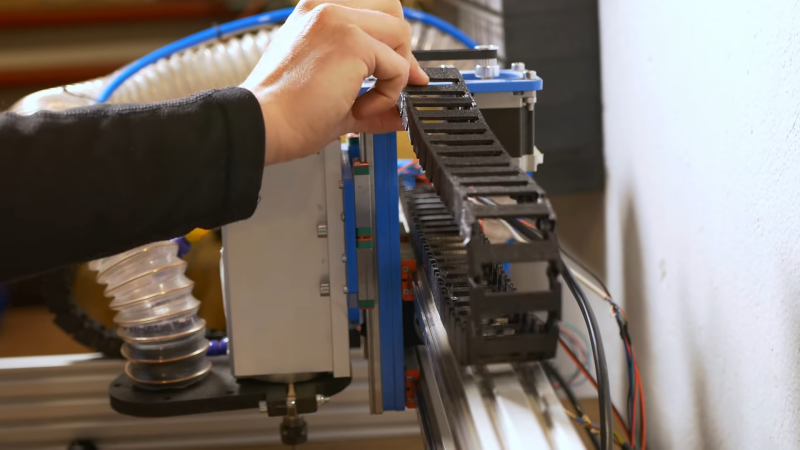CNC machines and 3D printers tend to have plenty of cabling which must be neatly managed while the machine moves. If not properly taken care of, wires can easily end up tangled in the moving bits leading to a dead machine at best, and some kind of raucous fire at worst. [Nikodem Bartnik] decided to create his own cable chains for his CNC build to keep everything in check.
The benefit of cable chains is that they stop cables splaying everywhere while still allowing them to move as needed with the axes of the machine. [Nikodem] created 20mm and 40mm chains for his build, affixed into the aluminium extrusion with bolts and T-nuts for easy assembly. The chains are assembled by hand, with 3D printed clips that hammer in place to hold the cables inside once inserted.
Of course, there’s nothing stopping you from buying cable chains off the shelf. But if you don’t want to wait for shipping in this era of cursed supply chains, or you want a cable chain you can customize to perfectly suit your machine, making your own could be the way to go.















“The benefit of cable chains is that they stop cables splaying everywhere while still allowing them to move as needed with the axes”
Well, yah, they do that. They also enforce a minimum bend radius without which wires connecting moving pieces would likely wear through and break in a very short time.
This isn’t exactly new or novel – there are cable chain designs on Thingiverse that are well over a decade old at this point. This particular design seems to just complicate older designs without adding any value?
Considering design time, setup time, materials cost, and post processing time, printing cable chains has never made sense versus purchasing an off the shelf part (for me). I’ve custom designed final links to affix chains to a machine, but otherwise I just find an appropriate standard chain and buy it.
Unless you have an absolutely massive build area, a large chain like that can take just as long to print as having it shipped direct to you. Mass produced injection molded plastic parts aren’t really in any sort of supply chain crunch for a homegamer right now, anyway. Plus FDM printed parts are never going to move as smoothly as injected molded parts.
Man, I didn’t want to be a crank but (even as a 3d printing enthusiast) not everything needs to be 3d printed! You don’t need to start from scratch on every project. Learn from those who’ve already solved the problem! You can even find whitepapers from cable chain manufacturers all about the design considerations involved: https://lappchina.lappgroup.com/fileadmin/DAM/Lapp_China/Catalogue/Whitepaper_Cable_Chain_Engineering_Guideline_EN.pdf
Seems to me if you want to make your own cable chain laser cut sheet plastic, a heat bender and solvent glue (or folded steel if you prefer) are the obvious way to knock out a decent mass production of your specific cable chain needs over 3d printing, as they will be so much smoother moving, more durable and less post processing effort it seems to me – just seems a better method…
Nice job on the modeling, but it’s not exactly new. These have been available on thingiverse pretty much since thingiverse first started.
Very cool and well done. DIY at it’s best.
I got my first 3D printer over 5 years ago and the files for making the cable chains existed then. This is seriously nothing new. The cable chains were among the first things I printed. It may have been less expensive to buy them but I had the printer and wanted to see it go. In fact the first bunch of things I printed were parts for my 3D printer.
Printed cable chains are cool and all, but for applications where you don’t have many thick wires (for example on a 3d printer’s x and y axis) you can simply use a measuring tape. It will keep straight where it has to be straight, and bend where it has to bend. In fact I think there was an article about that here
Do you mean this? https://hackaday.com/2017/12/17/diy-cable-chain-looks-great-stays-cheap/
That awesome for me that’s even better than the post, since it only addes a tiny bit to the diameter. The idea there in the comments to put the tape oöin the outer sleeve is pretty neat too.
I used this for getting some wires to the cutting head on K40 laser cutter. The smaller size was a real benefit and worked well for reinforcing flat cable. But for thick cables measurement tape would have too small bend radius.
Tapemeasures come in a few sizes, with somewhat different bend radius so perhaps you can still use one for thicker cables, can also slide some cable chain like bits over it to increase its bend radius if like I suppose.
Shoot, I printed chains for my old Printrbot Simple Metal some time ago. I still have the (butt-ugly) modifications I made for the landing points for the chain still on Thingiverse.
Sure, they never were butter smooth, movement wise, but they did what they were supposed to do, which was keeping the cable harness out of harms way. Printrbot’s method was that clear plastic cable wrap and praying to deities that it didn’t get hung up on the Y(or x, I don’t remember) axis as the print progressed.